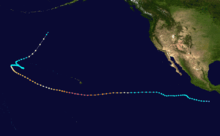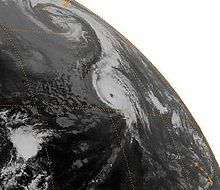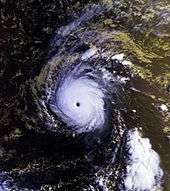Hurricane John (1994)
| Category 5 major hurricane (SSHWS/NWS) | |
 Hurricane John near peak intensity to the south of Hawaii on August 24 | |
| Formed | August 11, 1994 |
|---|---|
| Dissipated | September 10, 1994 |
| Highest winds |
1-minute sustained: 175 mph (280 km/h) |
| Lowest pressure | ≤ 929 mbar (hPa); 27.43 inHg |
| Fatalities | None reported |
| Damage | $15 million (1994 USD) |
| Areas affected | Hawaii, Johnston Atoll, Alaska |
| Part of the 1994 Pacific hurricane season and 1994 Pacific typhoon season | |
Hurricane John, also known as Typhoon John, formed during the 1994 Pacific hurricane season and became both the longest-lasting and the farthest-traveling tropical cyclone ever observed. John formed during the El Niño of 1994–95[1] and peaked as a Category 5 hurricane on the Saffir–Simpson hurricane wind scale, the highest categorization for hurricanes.
Over the course of its existence, it followed a 7,165-mile (13,280-km) path from the eastern Pacific to the western Pacific and back to the central Pacific, lasting 31 days in total.[2] Because it existed in both the eastern and western Pacific, John was one of a small number of tropical cyclones to be designated as both a hurricane and a typhoon. Despite lasting for a full month, John barely affected land at all, bringing only minimal effects to the Hawaiian Islands and the United States military base on Johnston Atoll. Its remnants later affected Alaska.
Meteorological history

The origins of Hurricane John were thought by the United States National Hurricane Center (NHC) to be from a tropical wave that moved off the coast of Africa on July 25, 1994.[3][4] The wave subsequently moved across the Atlantic Ocean and Caribbean without distinction, before it crossed Central America and moved into the Eastern Pacific Ocean on or around August 8.[3][4] Upon entering the Eastern Pacific the wave gradually developed, before the NHC initiated advisories on the system and designated it as Tropical Depression Ten-E during August 11.[5] The system was at this time moving westwards and located around 345 miles (555 km) to the south-southeast of Acapulco, Mexico.[3][4] Quickly developing banding features and well-defined outflow, it was upgraded to a tropical storm and named John later that day.[2]
A strong ridge of high pressure over the northeastern Pacific Ocean forced John westward, where upper level wind shear kept John a tropical storm. Intensity fluctuated considerably, however, as shear levels varied. More than once, shear cleared away most of the clouds above John and nearly caused it to weaken to a tropical depression.[2] However, after eight days of slow westward movement across the Pacific Ocean, shear lessened greatly on August 19, and John intensified significantly and was designated as a hurricane at 1700 PDT. During an eighteen-hour period between August 19 and August 20, John further strengthened from a weak Category 1 hurricane to a major Category 3 hurricane. Around 1100 PDT on August 20, it crossed into the central Pacific, the first of three basin crosses John would make.[2]
After entering the central Pacific, John left the area monitored by the NHC and was instead monitored by the Central Pacific Hurricane Center (CPHC). As it moved slowly westward, Hurricane John continued to strengthen considerably in an increasingly favorable environment well south of the Hawaiian Islands; on 22 August John was designated a Category 5 hurricane on the Saffir–Simpson hurricane scale (the highest classification for hurricanes) and later that day (by Hawaii Standard Time) reached its peak winds of 175 miles per hour (280 km/h).[6] Also on August 22 (by Hawaii Standard Time), John made its closest approach to the Hawaiian Islands, 345 miles (500 km) to the south. John had threatened to turn north and affect the islands days before, but the ridge of high pressure that typically shields the islands from hurricanes kept John on its southerly path. Nonetheless, heavy rains and wind from the outer bands of John affected the islands.[6]
With the Hawaiian Islands behind it, John began a slow turn to the north, taking near-direct aim at Johnston Atoll, a small group of islands populated only by a United States military base. The storm slowly weakened from its peak as a Category 5 hurricane in the face of increasing shear, dropping down to a Category 1 hurricane with 90 miles per hour (145 km/h) maximum winds. On August 25 local time, John made its closest approach to the Johnston Atoll only 15 miles (24 km) to the north. On Johnston Atoll, sustained winds were reported up to 60 miles per hour (95 km/h), the equivalent of a strong tropical storm, and gusts up to 75 miles per hour (120 km/h) were recorded.[7]

Clearing Johnston Atoll, John turned to the northwest and began strengthening again as shear decreased. On August 27 local time, John reached a secondary peak strength of 135 miles per hour (210 km/h), and shortly thereafter it crossed the International Date Line at approximately 22° N and came under the surveillance of the Guam branch of the Joint Typhoon Warning Center (JTWC). By crossing into the western Pacific, John also became a typhoon and was referred to as Typhoon John during its time in the western Pacific.[7] Immediately after crossing the Date Line, John again weakened and its forward motion stalled. By September 1, John had weakened to a tropical storm and was nearly motionless just west of the Date Line. There, John lingered for six days while performing a multi-day counterclockwise loop. On September 7, a trough moved into the area and quickly moved John to the northeast. John crossed the Date Line again on September 8 and reentered the central Pacific.[7]
After reentering the central Pacific, John briefly reached a tertiary peak strength of 90 miles per hour (145 km/h), a strong Category 1 hurricane, well to the north of Midway Island. However, the trough was rapidly pulling apart John's structure, and the cold waters of the northern central Pacific were not conducive to a tropical cyclone. On September 10, the 120th advisory was released on the system, finally declaring John to have become extratropical approximately 1000 miles (1600 km) south of Unalaska Island.[7]
Forecasting difficulties
During John's time in the Western North Pacific, the Joint Typhoon Warning Center (JTWC) had particular difficulty in forecasting and even estimating the strength of John. John weakened considerably after entering the Western North Pacific, and, before estimates were later revised, four consecutive advisories were issued that declared John a tropical depression. Each of these advisories called for imminent dissipation. As John persisted and did not dissipate as the JTWC had predicted, it was upgraded to a minimal tropical storm in the next advisory. At the same time, however, two separate ship reports indicated that John had sustained winds of at least 55 knots (100 km/h, 65 mph), far stronger than the advisory strength of 35 knots (65 km/h, 40 mph). John would go on to restrengthen into a strong Category 1 hurricane after reentering the Central North Pacific, defying all JTWC predictions. After later reanalysis, the JTWC raised the estimated wind speeds of John for every advisory from 1200 UTC September 1 to its final advisory exactly a week later by at least 5 knots (9 km/h, 6 mph) and as much as 25 knots (46 km/h, 29 mph).[8]
Records
Its 31-day existence made John the longest-lasting tropical cyclone recorded in both the Pacific Ocean and worldwide, surpassing both Hurricane Tina's previous record in the Pacific of 24 days in the 1992 season and the 1899 San Ciriaco hurricane's previous world record of 28 days in the 1899 Atlantic season.[9] In addition, despite its slow movement throughout much of its path, John was the farthest-traveling tropical cyclone in both Pacific Ocean and worldwide, with a distance traveled of 7,165 miles (13,280 km), out-distancing previous record holders Hurricane Fico in the Pacific of 4,700 miles (8,700 km) in the 1978 season and Hurricane Faith worldwide of 6,850 miles (12,700 km) in the 1966 Atlantic season.[10]
Pressure readings from John's peak are not consistently available as the CPHC did not monitor pressures at the time, but Air Force Reserve aircraft did measure a surface pressure of 929 mbar (hPa), making John one of the most intense hurricanes recorded in the central Pacific; both Hurricane Emilia and Hurricane Gilma recorded a lower pressure in the central Pacific earlier in the 1994 season, but with lower wind speeds. (Intensity is measured by minimum central pressure, which correlates with but is not directly linked to wind speeds). John was also only the fourth Category 5 hurricane recorded in the central Pacific (the first was Hurricane Patsy in 1959, the second was Hurricane Emilia and the third one was Hurricane Gilma, both earlier in 1994), and possessed the highest recorded wind speed in a central Pacific hurricane, 175 mph (280 km/h).[6] Since 1994, only one Category 5 hurricane, Hurricane Ioke, has formed in or entered into the Central Pacific; Ioke, like Emilia and Gilma, had a lower central pressure but lower wind speeds than John. However, John's pressure record is incomplete; the 929 mbar reading was only measured when the winds were 160 mph; there is no pressure reading when it had winds of 175 mph, so it could have been stronger than Emilia, Gilma or Ioke.[11] Also, John was the first hurricane formed in the eastern Pacific that become a typhoon, a feat only matched by Hurricane Genevieve in 2014.[12]
Additionally, counting only storms recognized by all north Pacific official Regional Specialized Meteorological Centers, John was only the third of five tropical cyclones to exist in all three tropical cyclone basins in the Pacific Ocean. The others were Tropical Storm Georgette and hurricanes Li, Dora and Genevieve in 1986, earlier in 1994, 1999 and 2014, respectively.[13][14][15][16] Also, John was the fifth of seven tropical cyclones to enter the central Pacific from the western Pacific. Hurricanes Patsy and Skip and tropical storms Virginia and Carmen in 1959, 1985, 1968 and 1980, respectively, had done so previously, and only Tropical Depression 17W and Tropical Storm Omeka in 1996 and 2010, respectively, did so later.[7][13][15][16] Finally, John was one of only five tropical cyclones to cross the Date Line twice, alongside hurricanes Patsy and Skip, Tropical Storm Carmen and Tropical Depression 17W.[13][17]
Impact

John affected both the Hawaiian Islands and Johnston Atoll, but only lightly. While John passed over 345 miles (550 km) to the south of Hawaiʻi, the islands did experience strengthened trade winds and rough surf along the southeast- and south-facing shores, and, as John moved westward, on west-facing shores as well.[7] The waves, ranging from 6 to 10 ft (1.8 to 3.0 m) in height, flooded beach parks in Kailua-Kona.[18] Additionally, heavy rains on the Big Island of Hawaiʻi caused minor, localized flooding and some short-term road closures. No deaths, injuries or significant damages were reported in Hawaiʻi.[7]
Although John passed within 25 km (16 mi) of Johnston Atoll, it had weakened greatly to a Category 1 system by closest approach.[7] Prior to the storm's arrival, waves between 20 and 30 ft (6.1 and 9.1 m) were reported on the island.[19] Additionally, in the Northern Hemisphere, the strongest winds and heaviest rain lie to the north of a tropical cyclone, so the atoll, which lay to the south of the storm's path, was spared the brunt of the storm. Nonetheless, the 1,100-man personnel for the United States military base on Johnston Atoll had been evacuated to Honolulu as a precaution while John approached. Damage to structures was considerable, but the size of the island and relative functionality of the base led to low damage; monetary losses were estimated at close to $15 million (1994 US$).[7]
The remnants of John moved through the Aleutian Islands, producing a wind gust of 46 mph (74 km/h) in Unalaska. The storm brought a plume of warm air, and two stations recorded a high temperature of 66 °F (19 °C).[20]
See also
References
- ↑ "Cold and Warm Episodes by Season". August 4, 2014. Retrieved August 11, 2014.
- 1 2 3 4 Lawrence, Miles (1995). "Hurricane John Preliminary Report (page 1)". NOAA. Retrieved May 22, 2006.
- 1 2 3 Lawrence, Miles B (January 3, 1995). Preliminary Report: Hurricane John: August 11 - September 10, 1994 (gif) (Report). United States National Oceanic and Atmospheric Administration's National Weather Service's National Hurricane Center. p. 1. Archived from the original on August 11, 2014. Retrieved August 11, 2014.
- 1 2 3 Mayfield, Britt Max; Pasch, Richard J (1996). "Eastern North Pacific Hurricane Season of 1994" (PDF). Monthly Weather Review. American Meteorological Society. 124: 1585–1586. Bibcode:1996MWRv..124.1579P. doi:10.1175/1520-0493(1996)124<1579:ENPHSO>2.0.CO;2. Retrieved August 11, 2014.
- ↑ Lawrence, Miles B (August 11, 1994). Tropical Depression Ten-E Discussion Number 1: August 11, 1994 09z (Report). United States National Oceanic and Atmospheric Administration's National Weather Service's National Hurricane Center. Archived from the original on August 11, 2014. Retrieved August 11, 2014.
- 1 2 3 Lawrence, Miles (1995). "Hurricane John Preliminary Report (page 2)". NOAA. Retrieved May 23, 2006.
- 1 2 3 4 5 6 7 8 9 Central Pacific Hurricane Center (2004). "Hurricane John Preliminary Report". NOAA. Retrieved May 24, 2006. (Note that this report does not reflect changes made in post-season analysis.)
- ↑ "Annual Tropical Cyclone Report" (PDF). Joint Typhoon Warning Center. 1994. pp. 128–133. Retrieved December 4, 2006.
- ↑ Dorst, Neal (2004). "Which tropical cyclone lasted the longest?". NOAA Tropical cyclone FAQ. NOAA. Retrieved May 22, 2006.
- ↑ Dorst, Neal (2004). "What is the farthest a tropical cyclone has traveled?". NOAA Tropical cyclone FAQ. NOAA. Retrieved May 22, 2006.
- ↑ National Hurricane Center; Hurricane Research Division; Central Pacific Hurricane Center. "The Northeast and North Central Pacific hurricane database 1949–2015". United States National Oceanic and Atmospheric Administration's National Weather Service. A guide on how to read the database is available here.
- ↑ Kristina Pydynowski (August 7, 2014). Rare Switch for Genevieve: Hurricane to Super Typhoon (Report). Accuweather. Retrieved August 7, 2014.
- 1 2 3 Central Pacific Hurricane Center. "Previous Tropical Systems of the Central Pacific". Archived from the original on 23 February 2007. Retrieved 2007-02-23.
- ↑ "Eastern North Pacific Tracks File 1949–2007". Atlantic Oceanographic and Meteorological Laboratory. March 21, 2008. Archived from the original on August 22, 2008. Retrieved March 3, 2009.
- 1 2 Central Pacific Hurricane Center. "CPHC Rebest 1966-2003" (XLS). Retrieved August 15, 2016.
- 1 2 "JMA Best Track Data" (TXT). Japan Meteorological Agency. Retrieved August 15, 2016.
- ↑ Pao-Shin Chu; Peng Wu (2008). Climatic Atlas of Tropical Cyclone Tracks over the Central North Pacific (PDF) (Report). University of Hawaii-Manoa. Retrieved August 2, 2015.
- ↑ National Climatic Data Center (1994). "Event Report for Hawaii". Archived from the original on January 12, 2012. Retrieved May 28, 2006.
- ↑ Staff Writer (August 26, 1994). "Island braces for Hurricane John". Gainesville Sun. p. 4. Retrieved December 12, 2009.
- ↑ "Storm Data: A Composite of Outstanding Storms". 36 (9). September 1994: 60. Archived from the original (PDF) on 2014-08-12. Retrieved 2012-04-22.
External links
| Wikimedia Commons has media related to Hurricane John (1994). |
- The National Hurricane Center's report on Hurricane John
- The Central Pacific Hurricane Center's report on Hurricane John
- The Joint Typhoon Warning Center's 1994 Annual Tropical Cyclone Report
